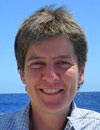|
  Today's Weather Partly cloudy New Hot Topic:
January 6, 2008 (posted January 7, 2008) by Susan Humphris, edited by Kristen Kusek A good rule of thumb on any research cruise is to expect the unexpected. We were reminded of this today, our first day at our research site, when one of the machines that scientists use to hoist and haul equipment in and out of the water—which is as important to seagoing operations as say, a reel is to a fisherman—broke. These machines, called the “hydrowinches,” look like huge, rotating reels wound with lots of strong wire, which let wire out into the water, or pull it in. In order to keep the wire from scraping against the side of the ship as it runs from the winch to the water, the wire is led from the winch, up around a pulley (or “sheave” in nautical terms) attached to a horizontal “boom”—an arm-like crane that telescopes out over the water. Early this morning the throttle that controls the wire on the hydrowinch failed, bringing good news and bad news. The bad news was that this type of problem cannot be fixed in a hurry, even if we had the spare parts on hand. The good news was that the Knorr actually has two hydrowinches – one on its port (left) side, and the other on its starboard (right). We’d been using the port one. Couldn’t we just use the starboard one? But it wasn’t a simple matter of “switch the winch” (Say that ten times fast!). When you lead a wire from a different winch, it needs its own pulley at the end of the boom. That’s why the Knorr has two pulleys in different spots on the end of the boom—one for wire from the port winch, and one for wire from the starboard winch (see slide 2 in today’s slideshow). When a wire is led from a winch out to the end of the boom and over the pulley, it is important that it has what mariners call a “fairlead”—that is, the wire is routed in such a way that it doesn’t chafe or get bends in it, and the pulley can work properly and safely. The portside winch is the best one to use for CTD work because its pulley is on the back edge of the boom, so it is free to swing backwards as the ship tows the CTD. As the ship moves forward, towing a piece of equipment behind the ship, the wire will run backward from the boom into the water. But today, our only hope was to use the only working winch: the less-ideal starboard winch, which has its pulley on the front edge of the boom. So Pete Liarikos, the ship’s bosun, strapped on a safety harness and climbed out to the end of the boom, where he rigged the forward pulley that provides the “fairlead” for the wire from the starboard winch. We tried our tow-yo again. But this time the pulley was in danger of hitting the boom as the ship moved forward, and the pulley was pulled backward by the weight of the CTD dragging in the water behind. It’s a good thing the Knorr crew seems motivated by challenges rather than defeated by them. The next one to come up with a creative solution to the problem was the Chief Mate, Adam Seamans, who was on the bridge. Why not do the tow-yo with the ship going backwards?! That way, the wire would lead forward instead of backwards, and the pulley would swing freely while the Knorr was doing the equivalent of the Michael Jackson “moon walk” dance. (You can find that on “YouTube” if you haven’t seen it!) So, after repositioning the ship, Ko-ichi Nakamura, our tow-yo expert from Japan, lowered the CTD back into the water and, as the ship drifts sideways and backward (see slide 8 in today’s slide show), we are collecting data—and hopefully homing in on the vent site first detected by British and U.S. scientists in 2005. Join us again tomorrow for another day of the unexpected—which we like to call discovery! Read the interview
[ Previous day ] [ Next day ]
|
||
Mailing List | Feedback | Glossary | For Teachers | About Us | Contact
© 2010 Dive and Discover™. Dive and Discover™ is a registered trademark of Woods
Hole Oceanographic Institution



